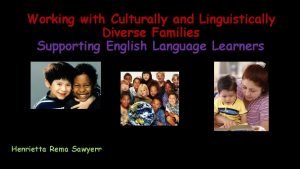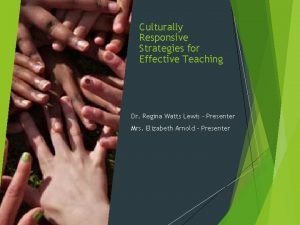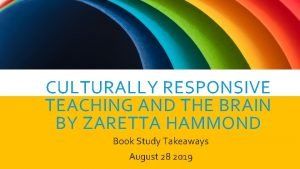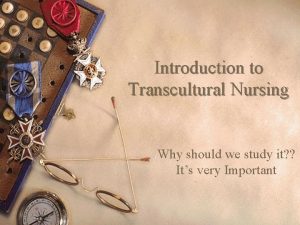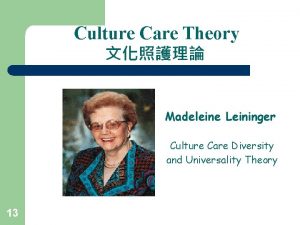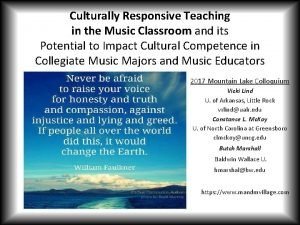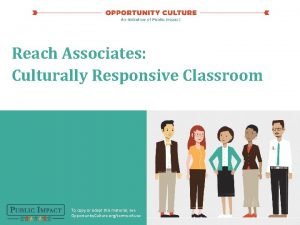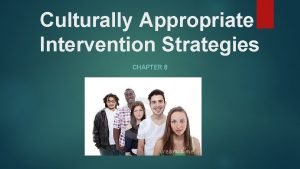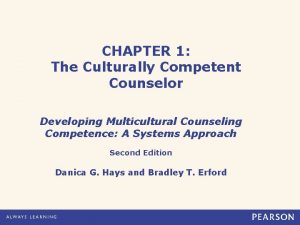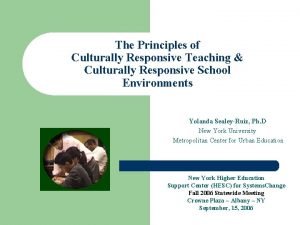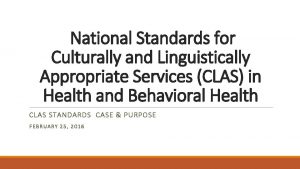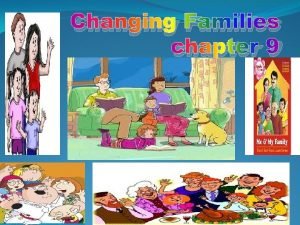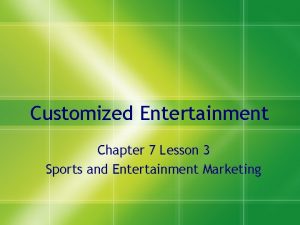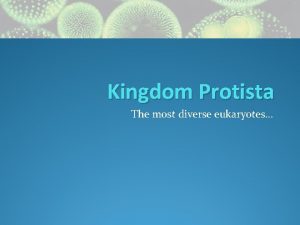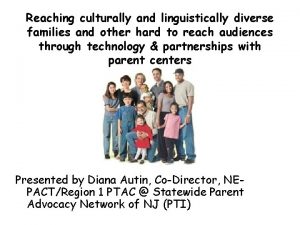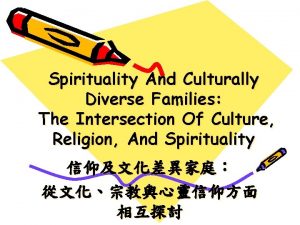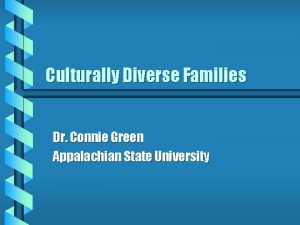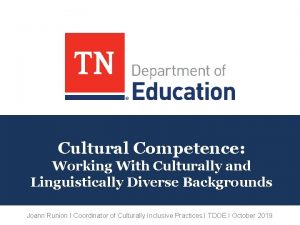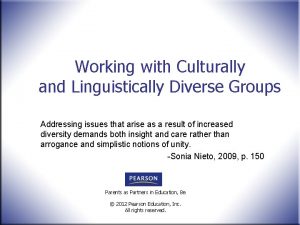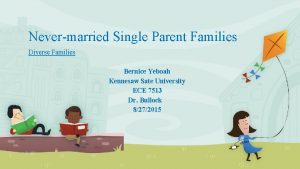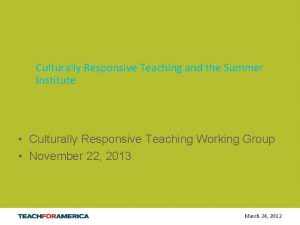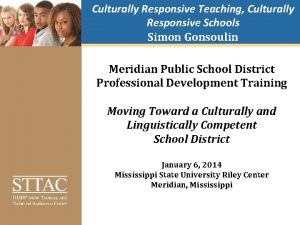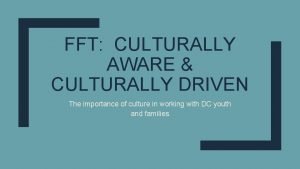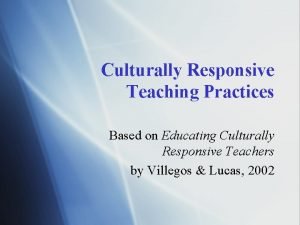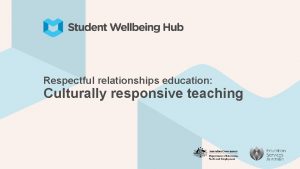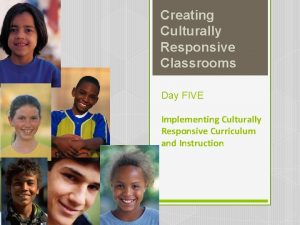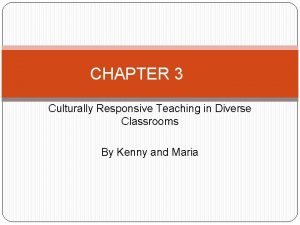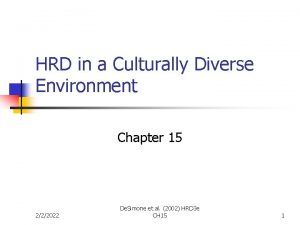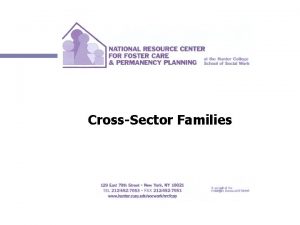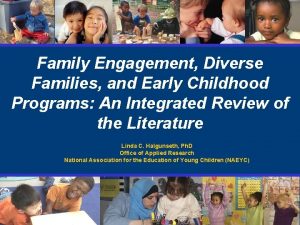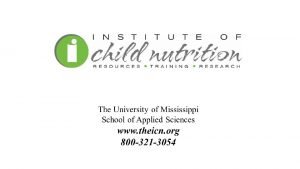CHAPTER 5 Working with Culturally Diverse Families Family






























- Slides: 30

CHAPTER 5: Working with Culturally Diverse Families Family Therapy: History, Theory, and Practice 6 th Edition Samuel T. Gladding Developed by Nathaniel N. Ivers, Wake Forest University © (2015, 2011, 2007) by Pearson Education, Inc. All Rights Reserved

Overview • Differences in culture and ethnicity regarding family • Working with gay and lesbian families • Working with culturally diverse families • Working with specific cultural family groups • African American Families • Asian American Families • Hispanic/Latino Families • Native American Families • Arab American Families • European American Families Gladding, Family Therapy: History, Theory, and Practice, 6 th Ed. © (2015, 2011, 2007) by Pearson Education, Inc. All Rights Reserved 5 -2

Terms related to Culture • Culture • Multicultural • Intercultural couples • Integration • Coexistence • Lack of resolution • Worldview • Cultural competency Gladding, Family Therapy: History, Theory, and Practice, 6 th Ed. © (2015, 2011, 2007) by Pearson Education, Inc. All Rights Reserved 5 -3

Dynamics of Culturally Diverse Families • Overt and covert criticism of patterns of family interaction • Appearance • Access to mental health services • Economics Gladding, Family Therapy: History, Theory, and Practice, 6 th Ed. © (2015, 2011, 2007) by Pearson Education, Inc. All Rights Reserved 5 -4

Issues in Working with Culturally Diverse Families • Sensitivity • Experience • Acceptance • Ingenuity • Specificity • Intervention Gladding, Family Therapy: History, Theory, and Practice, 6 th Ed. © (2015, 2011, 2007) by Pearson Education, Inc. All Rights Reserved 5 -5

Working with Gay and Lesbian Families • Four percent of Americans identify themselves as gay or lesbian (Centers for Disease Control and Prevention, 2013) • Approximately 1 in 10 cases in marriage and family therapy are involves gays or lesbians Gladding, Family Therapy: History, Theory, and Practice, 6 th Ed. © (2015, 2011, 2007) by Pearson Education, Inc. All Rights Reserved 5 -6

Gay and Lesbian Families • Gay and lesbian families are intergenerational • A cycle to gay and lesbian family life • Gay and lesbian families are varied • Gay and lesbians couples have mixed levels of satisfaction in their relationships Gladding, Family Therapy: History, Theory, and Practice, 6 th Ed. © (2015, 2011, 2007) by Pearson Education, Inc. All Rights Reserved 5 -7

Therapists Working with Gay and Lesbian Families • Work with self to sort out feelings regarding gay and lesbian families • Address both external and internal issues associated with being a gay or lesbian couple or family • Work with society at large and its institutions to deal with matters of prejudice and discrimination • Recognize that gay and lesbian families deal with matters besides their sexual orientation Gladding, Family Therapy: History, Theory, and Practice, 6 th Ed. © (2015, 2011, 2007) by Pearson Education, Inc. All Rights Reserved 5 -8

African American Families • Second largest minority group in the U. S. , comprising 13% of the population • African American families are diverse regarding background and traditions • Commonalities • Many have ancestors who were brought to Americas as slaves • Dark skin color differentiates them from the majority of people in the United States • May face racism and discrimination, resulting in socioeconomic disadvantage and stress Gladding, Family Therapy: History, Theory, and Practice, 6 th Ed. © (2015, 2011, 2007) by Pearson Education, Inc. All Rights Reserved 5 -9

Strengths of African American Families • Kinship bonds • Religious orientation and spirituality • Cooperation • Motivation to achieve • Role adaptability • Caring parenting • Family structure • Strong work orientation Gladding, Family Therapy: History, Theory, and Practice, 6 th Ed. © (2015, 2011, 2007) by Pearson Education, Inc. All Rights Reserved 5 -10

Factors Affecting African American Families The following negative factors may affect African American families: • Surveillance by mental health and social work professionals regarding strict parenting practices • Tension with male-female relationships • Outside pressures such as racism, prejudice, poverty, and discrimination Gladding, Family Therapy: History, Theory, and Practice, 6 th Ed. © (2015, 2011, 2007) by Pearson Education, Inc. All Rights Reserved 5 -11

Family Therapists Working with African American Families • Provide psychoeducation when appropriate • Be attuned to African American experiences and perceptions • Understand multigenerational family systems • Be sensitive to the importance of respect for elderly family members • Assure families that through therapeutic process they can learn how to handle many of their problems Gladding, Family Therapy: History, Theory, and Practice, 6 th Ed. © (2015, 2011, 2007) by Pearson Education, Inc. All Rights Reserved 5 -12

Working with African American Families • Address social and institutional issues adversely affecting African Americans • Address concerns bout having a non-African American therapist, if applicable • Do not assume familiarity with the family in first sessions • Join with family before gathering sensitive information • Conduct home visits, if needed • Acknowledge strengths, successes, and resources • Use appropriate metaphors and scriptural references when appropriate Gladding, Family Therapy: History, Theory, and Practice, 6 th Ed. © (2015, 2011, 2007) by Pearson Education, Inc. All Rights Reserved 5 -13

Asian American Families • Constituted about 5% of U. S. population in 2011 • Projected to number 20 million by 2020 • Trace cultural heritage to a variety of countries, such as Japan, Philippians, Pacific Islands, etc. • Differ in regards to language, history, and socioeconomic factors • Share many cultural values, such as respect for elderly, extended family support, family loyalty, and high value on education, as well as values associated with self-discipline, order, social etiquette, and hierarchy. Gladding, Family Therapy: History, Theory, and Practice, 6 th Ed. © (2015, 2011, 2007) by Pearson Education, Inc. All Rights Reserved 5 -14

Working with Asian American Families • Take acculturation into account • Be aware of the effect of racism on Asian American families • Recognize the potential importance of being knowledgeable of Asian philosopher • Create a safe and nurturing environment that mirrors a supportive and caring family Gladding, Family Therapy: History, Theory, and Practice, 6 th Ed. © (2015, 2011, 2007) by Pearson Education, Inc. All Rights Reserved 5 -15

Working with Asian American Families • Assess support available to the family • Assess past history of immigration • Establish professional credibility • Be problem focused/present focused • Be directive in guiding therapy process • Provide reframing that encourages the family Gladding, Family Therapy: History, Theory, and Practice, 6 th Ed. © (2015, 2011, 2007) by Pearson Education, Inc. All Rights Reserved 5 -16

Hispanic/Latino American Families • Comprises one in every six residents of the United States • Nations largest minority • Most Hispanic/Latino families trace their ancestry to Mexico, Cuba, or Puerto Rico. • Considerable diversity exists among Hispanics/Latinos and their families • Tend to be family-oriented Gladding, Family Therapy: History, Theory, and Practice, 6 th Ed. © (2015, 2011, 2007) by Pearson Education, Inc. All Rights Reserved 5 -17

Common Hispanic/Latino Cultural Values • Collectivistic • Dignidad (dignity) • Orgullo (pride and self-reliance) • Confianza (trust and intimacy) • Respeto (respect) • Simpatía (smooth, pleasant relationships) • Personalismo (Individualized self-worth) • Familismo (family connectedness) • Marianismo (female self-sacrifice) • Machismo (male self-respect and responsibility) (Carlson et al. , 2004) Gladding, Family Therapy: History, Theory, and Practice, 6 th Ed. © (2015, 2011, 2007) by Pearson Education, Inc. All Rights Reserved 5 -18

Working with Hispanic/Latino Families • Develop a basic knowledge about cultural traditions before attempting to employ treatment modalities • Take into account personalismo • Be aware of socioeconomic factors affecting Hispanic/Latino families • Assess for acculturation level as well as acculturative stress • Utilize outside resources to facilitate treatment, such as the Catholic church • Be aware of potential family hierarchy and roles Gladding, Family Therapy: History, Theory, and Practice, 6 th Ed. © (2015, 2011, 2007) by Pearson Education, Inc. All Rights Reserved 5 -19

American Indians and Alaska Native Families • Approximately 3. 6 million American Indians and Alaska Natives live in the United States • Extremely diverse group • Belong to 557 federally recognized and staterecognized nations • Traditionally, their lives built around harmony, acceptance, cooperation, sharing, and respect for family and nature • Importance of extended family Gladding, Family Therapy: History, Theory, and Practice, 6 th Ed. © (2015, 2011, 2007) by Pearson Education, Inc. All Rights Reserved 5 -20

Challenges for American Indian / Alaska Native Families • Break up or dysfunctionality of families • Geography and culture (biculturalism) • Joblessness, poverty, gangs, and substance abuse Gladding, Family Therapy: History, Theory, and Practice, 6 th Ed. © (2015, 2011, 2007) by Pearson Education, Inc. All Rights Reserved 5 -21

Working with American Indian and Alaska Native Families • No one size fits all model • Cultural knowledge, sensitivity, and innovation • Build relationships with local leaders and communities • Recognize culturally sensitive techniques • Recognize interconnectedness between physical and psychological distress • Consider the use of home-based therapy • Consider therapeutic techniques that are directive Gladding, Family Therapy: History, Theory, and Practice, 6 th Ed. © (2015, 2011, 2007) by Pearson Education, Inc. All Rights Reserved 5 -22

Arab American Families • Fast growing, mosaic group that is more than three-fourths immigrant • Large percentage are Christians; however, they make up the largest cohort of Muslims in U. S. • Tend to be high context rather than low context • Family is the most significant element in most Arab American subcultures • Traditionally, a patriarchal, hierarchical structure exists in the family Gladding, Family Therapy: History, Theory, and Practice, 6 th Ed. © (2015, 2011, 2007) by Pearson Education, Inc. All Rights Reserved 5 -23

Working with Arab American Families • May be reluctant to seek family therapy • Be aware of the potential emphasis on honor and shame • Be aware of cultural context in which the family operates • Be mindful of the issue of leadership and importance of authority figures in family Gladding, Family Therapy: History, Theory, and Practice, 6 th Ed. © (2015, 2011, 2007) by Pearson Education, Inc. All Rights Reserved 5 -24

Working with Arab American Families • Be attentive to the role of the extended family in decision-making • Be aware of the influence of culture on therapy • Consider a strengths-based approach • Balance activity so as not to be seen as a rescuer or a threat • Consider exploring identity issues • Concentrate on couple dynamics • When appropriate, focus on religious and other group support Gladding, Family Therapy: History, Theory, and Practice, 6 th Ed. © (2015, 2011, 2007) by Pearson Education, Inc. All Rights Reserved 5 -25

European American Families • Majority of people in the U. S. • It is assumed that European Americans embrace WASP values such as individualism, mastery over nature, competitiveness, and Christianity, that is not necessarily the case • Diverse group of people Gladding, Family Therapy: History, Theory, and Practice, 6 th Ed. © (2015, 2011, 2007) by Pearson Education, Inc. All Rights Reserved 5 -26

Working with European Americans • Consider using an existential approach, as it focuses on uniqueness • Consider incorporating universal techniques, such as genuineness, empathic understanding, and structuring Gladding, Family Therapy: History, Theory, and Practice, 6 th Ed. © (2015, 2011, 2007) by Pearson Education, Inc. All Rights Reserved 5 -27

Guidelines for Selecting Treatment Approaches with Culturally Diverse Families Two main approaches • • Culture-specific model • Universal perspective model Gladding, Family Therapy: History, Theory, and Practice, 6 th Ed. © (2015, 2011, 2007) by Pearson Education, Inc. All Rights Reserved 5 -28

Roles of the Therapist • Be aware of own cultural heritage and respect cultural differences • Be comfortable with differences that exist between themselves and the clients with regard to cultural backgrounds and beliefs • Be sensitive to circumstances that may dictate referral of a family • Be knowledgeable of own racist attitudes, beliefs, and feelings Gladding, Family Therapy: History, Theory, and Practice, 6 th Ed. © (2015, 2011, 2007) by Pearson Education, Inc. All Rights Reserved 5 -29

ESCAPE Four major investments 1. Engagement with families and process 2. Sensitivity to culture 3. Awareness of family potential 4. Knowledge of environment Gladding, Family Therapy: History, Theory, and Practice, 6 th Ed. © (2015, 2011, 2007) by Pearson Education, Inc. All Rights Reserved 5 -30
 Working with culturally and linguistically diverse families
Working with culturally and linguistically diverse families Culturally responsive vs culturally relevant
Culturally responsive vs culturally relevant How does it move
How does it move Individuals and families diverse perspectives
Individuals and families diverse perspectives Big families vs small families
Big families vs small families Definition of cultural deprivation
Definition of cultural deprivation Vdoe culturally responsive teaching
Vdoe culturally responsive teaching Culturally responsive teaching and the brain powerpoint
Culturally responsive teaching and the brain powerpoint Campinha-bacote model
Campinha-bacote model Madeleine leininger sunrise model
Madeleine leininger sunrise model Culturally responsive teaching in music education
Culturally responsive teaching in music education Culturally responsive classroom management
Culturally responsive classroom management Culturally responsive teaching self assessment
Culturally responsive teaching self assessment Culturally appropriate intervention strategies
Culturally appropriate intervention strategies Culturally competent counselor
Culturally competent counselor Culturally relevant pedagogy
Culturally relevant pedagogy National culturally and linguistically appropriate services
National culturally and linguistically appropriate services Chapter 16 a diverse heritage
Chapter 16 a diverse heritage Smart work and hard work
Smart work and hard work Disadvantages of cold working
Disadvantages of cold working Hot working and cold working difference
Hot working and cold working difference Differentiate between hot working and cold working
Differentiate between hot working and cold working Proses pengerjaan logam
Proses pengerjaan logam What changes occurred in nimmi's family
What changes occurred in nimmi's family Chapter 10. western musical instruments
Chapter 10. western musical instruments Chapter 7 lesson 3 help for families
Chapter 7 lesson 3 help for families Most diverse group of organisms
Most diverse group of organisms Reflectia si refractia luminii
Reflectia si refractia luminii Pyrrophyta
Pyrrophyta It diverse information sharing through universal web access
It diverse information sharing through universal web access Forma di stato
Forma di stato
